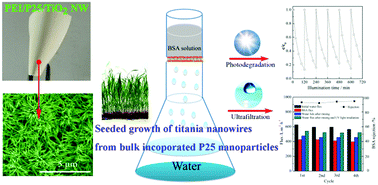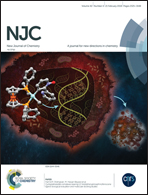Titania nanowires coated PEI/P25 membranes for photocatalytic and ultrafiltration applications†
Abstract
Polymeric membranes incorporated with TiO2 possess advantages in superhydrophilicity, anti-fouling, anti-microbial and pollutant degradation. Herein, we report a new synthetic route to fabricate TiO2 composited polymeric membranes for photocatalytic and ultrafiltration applications. A flexible hybrid membrane of polyetherimide (PEI) and commercial P25 TiO2 nanoparticles was firstly synthesized, which was then surface functionalized by quasi-aligned TiO2 nanowires adhering tightly to the membrane. The synthetic route involves multi-steps of surface roughening, titanate nanowire deposition and finally hot water treatment. The mercury porosimetry measurement shows that the membrane contains mesopores ranging from 2 to 100 nm with a peak maximum at 26 nm, and the porosity is ca. 48.7%. The TiO2 functionalized PEI/P25 membranes exhibited high and stable efficiency to enable photodegradation of rhodamine B in water under UV light illumination. They also possessed high hydrophilicity, permeability and resistance to fouling with bovine serum albumin (BSA) solution. The ultrafiltration tests show that the surface roughened PEI/P25 membrane exhibited a pure water flux of 2165 L m−2 h−1, with a BSA retention rate of only 3.2%. After precipitation with TiO2 nanowires, the BSA retention rate increased to 93.3% while a high water flux of 595 L m−2 h−1 was still attained. Further UV light illumination of the membrane achieved an increased water flux recovery ratio (FRR) of 88%, which suggests an enhanced antifouling performance when compared with the water rinsed one.



 Please wait while we load your content...
Please wait while we load your content...